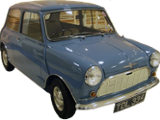Mini fans the world over are celebrating that the little car has been voted the highest placed European car by 130 of the world's leading journalists in the 'Car of the Century' awards at a glittering bash in Las Vegas.
Coming runner-up in the overall competition only to the grandfather of modern car manufacture - the Model T, Mini was recognized for the way the it changed the face of motoring with its radical transverse engine layout, astonishing packaging and remarkable handling. Fred van der Vlught, Chairman of the Car of the Century organisation said, "There was stiff competition for the title and it was a close race indeed. We were not sure of the winner until one hour before the awards as the votes were still coming in. I am delighted that Mini has been acknowledged in this way. It is very worthy of its placing." This highest accolade caps Mini's 40th birthday year in style and demonstrated that the best things really do come in small packages.
Attending the event was Jack Daniels, Chief Engineer of the original design team. Mr Daniels, 87, said, "This is a tremendous tribute to the car, the very talented design team which created the car forty years ago and all those involved with it to this day." History of the Mini Originally conceived by innovator Alec Issigonis, the Mini was intended to be the smallest possible car that would still accommodate four adults and luggage -- measuring approximately 10 feet long, 4 feet high and 4 feet wide. A chassis designer by background, Issigonis realized that he would need to use very small,10-inch wheels and all independent suspension, which was rare in the UK at the time. However, the truly brilliant solution was to employ a transverse engine, driving the front wheels via a gear box and final drive built into the sump of the engine -- a concept that had never been tried before. The Mini is one of the world's best-selling cars with 5.3 million produced to date. The Mini was launched on August 26, 1959 by the British Motor Corporation (BMC) in response to fuel rationing introduced with the Suez crisis. The Mini soon developed a style all its own and was the inspiration behind the naming of the famed mini skirt by Sixties fashion designer Mary Quant. "When the Mini automobile made its debut in Great Britain, many didn't know what to make of its small size and revolutionary features. However, the British press soon fell in love with the Mini, as did the fashionable `Chelsea set,' Sixties London's equivalent of today's younger, fashion-forward crowd," commented Tom Purves, chairman of the BMW Group in the US. "Famous people -- including Peter Sellers and Peter Ustinov -- began buying Minis and even members of the Royal Family were seen around town in the cheeky autos. People were beginning to realize that the Mini was more than just a car. It was a fashion statement and a whole new way of life." In addition to Sellers and Ustinov, other celebrities who have owned Minis include Sir Paul McCartney, Natalie Imbruglia, Ringo Starr, David Bowie and Kate Moss. A Brief Foray Into The US Market Less than a year from the first Mini rolling off the assembly line in England, the first Mini set tires in the US. Initially introduced under the Austin and Morris brands, the Mini offered thrilling performance yet everyday practicality. At a list price of $1,295 in 1960, it was a serious competitor to the $1,675 VW Beetle. With 35hp and a weight of 1,300 pounds, it was an even run for a 1200cc VW in a straight line, but in corners there was no comparison. Americans were fast tapping in to the Mini-mania that was building in Europe.
The US motoring press also greeted the Mini with an enthusiastic response. Sports Car Graphic magazine enthused "It spells FUN and ECONOMY in capitals and has more surprises than a visit to Disneyland." Sadly, the Mini's time in the US would be shortened by safety and emissions regulations. In all, slightly less than 10,000 Minis were sold in America between 1960 and 1967.
Mini Named 'European Car of The Century' in Awards Program
Sale Items
-
AHA7698List: $38.95SAVE: $19.70Clearance Price $19.25
-
SPRIN032$289.99
-
G2NMS7625List: $32.95SAVE: $13.26Clearance Price $19.69
-
G2NME2397EList: $3.62SAVE: $1.51Clearance Price $2.11
-
G2NMI1079List: $316.95SAVE: $116.95Clearance Price $200.00
-
21A1507List: $45.95SAVE: $23.13Clearance Price $22.82
-
SPRAU011$289.99
Please Wait








